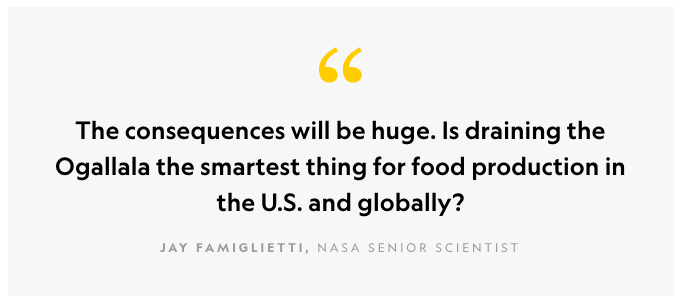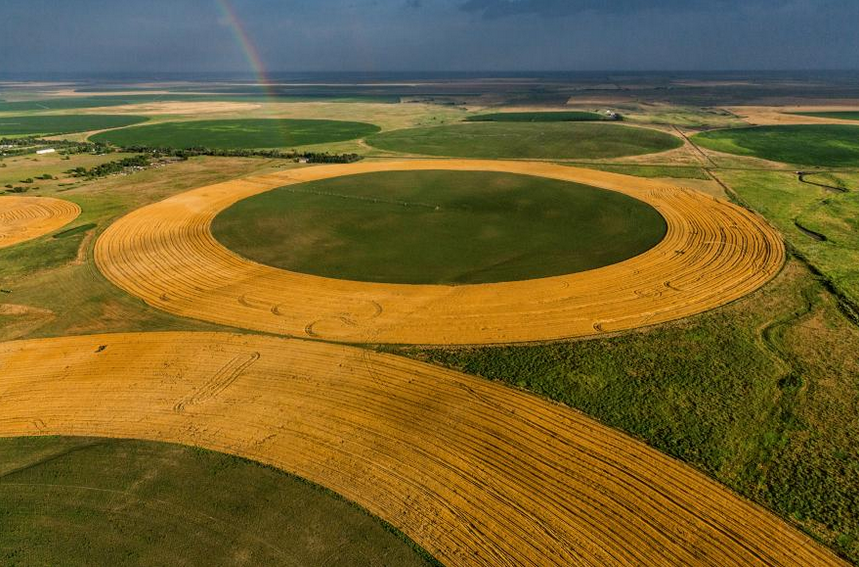National Geographic: What Happens to the U.S. Midwest When the Water’s Gone?

Left: Bedsprings once served as a corral near Elida, New Mexico, where turbines tap into the High Plains’ unrelenting wind, generating new income for farmers who have lost earnings as their wells dry up.
Right: Two-year-old Annalea Garcia is bathed nightly by her mother, Crystal, in a bucket filled with water hauled from town. Their well and the wells of some 30 other families on the outskirts of Clovis, New Mexico, have run dry.
by Laura Parker | August 2016
The Ogallala aquifer turned the region into America’s breadbasket. Now it, and a way of life, are being drained away.
This story appears in the August 2016 issue of National Geographic magazine.
“Whoa,” yells Brownie Wilson, as the steel measuring tape I am feeding down the throat of an irrigation well on the Kansas prairie gets away from me and unspools rapidly into the depths below.
The well, wide enough to fall into, taps into the Ogallala aquifer, the immense underground freshwater basin that makes modern life possible in the dry states of Middle America. We have come to assess the aquifer’s health. The weighted tip hits the water at 195 feet, a foot lower than a year ago. Dropping at this pace, it is nearing the end of its life. “Already this well does not have enough water left to irrigate for an entire summer,” Wilson says.
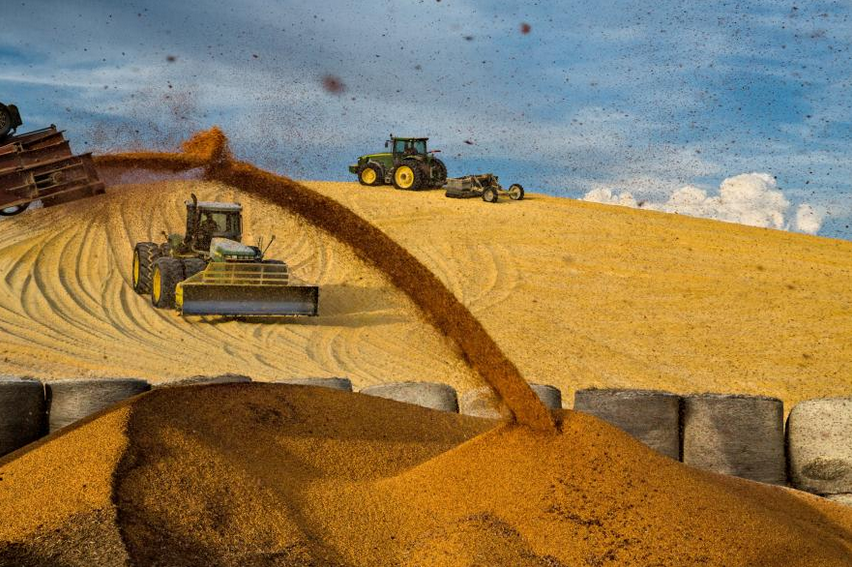
Tractors pack down a giant mound of corn at a feedlot near Imperial, Nebraska, before storm clouds roll in. Much of the region’s corn, a thirsty, irrigated crop, is grown to fatten cattle. This mound eventually would stretch 300 feet long, contain five million bushels, and feed 50,000 cattle for a year.
It is three days into January, and we are alone on an endlessly flat expanse surrounded by 360 degrees of pale blue horizon, not a cloud, not a tree in sight. We are 4,000 feet above sea level, the reason this is called the High Plains. The incessant wind that blew topsoil from the Dust Bowl east to the Atlantic Ocean and onto the decks of ships during the 1930s is unseasonably calm, although Wilson’s SUV is packed to the roof with gear for every possible weather calamity. On the field behind us, the spindly steel skeleton of a center-pivot irrigation sprinkler stretches out over brown earth like a giant sci-fi insect, dormant until spring.
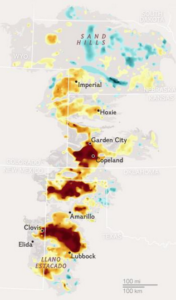
High Plains Aquifer
Explore the aquifer further, including the history of frustrated farmers, rainmakers, and cloud seeding, in our interactive version of this map.
Tagging along with Wilson, I am nearing the end of a 5,000-mile journey along the back roads of Ogallala territory, from South Dakota to Texas. My drive has taken me through some of the most productive farmland anywhere, home to at least a $20-billion-a-year industry that grows nearly one-fifth of the United States’ wheat, corn, and beef cattle. It’s also a place facing hard choices: Farmers can reduce consumption of water to further extend the life of the aquifer. Or they can continue on their path toward an end that is already in sight. Some don’t like to frame the dilemma quite so starkly. But if they don’t reduce pumping and the aquifer is drained, food markets will be profoundly affected around the world. In the coming decades this slow-speed crisis will unfold just as the world needs to increase food production by 60 percent, according to the United Nations, to feed more than nine billion people by mid-century.
The draining of North America’s largest aquifer is playing out in similar ways across the world, as large groundwater basins in Asia, Africa, and the Middle East decline rapidly. Many of these aquifers, including the southern Ogallala, have little ability to recharge. Once their water is gone, they could take thousands of years to refill.
“The consequences will be huge,” says Jay Famiglietti, senior water scientist at NASA Jet Propulsion Laboratory and lead researcher on a study using satellites to record changes in the world’s 37 largest aquifers. “We need to sustain groundwater to sustain food production, and we’re not doing it. Is draining the Ogallala the smartest thing for food production in the U.S. and globally? This is the question we need to answer.”
Wilson’s route takes us 20 miles east of the Colorado border, where little towns are named for springs that long ago ran dry. People who live on the Ogallala, also known as the High Plains aquifer, often describe their water as thick or thin. This is shorthand for the aquifer itself. The Ogallala is a giant underground sponge made of a jumble of gravel, silt, sand, and clay. All the water is contained in crevices of the sponge. If the topsoil were rolled up like a carpet, Wilson says, the sponge beneath would look like an empty egg carton, with peaks and valleys of varying depths. In parts of western Nebraska, where the Ogallala is plentiful, the sponge extends as far as a thousand feet below the Earth’s surface, meaning it is “thick” with water. In western Kansas, where we are, the aquifer undulates so much that “thin” water is often separated from thick water by only a few miles.
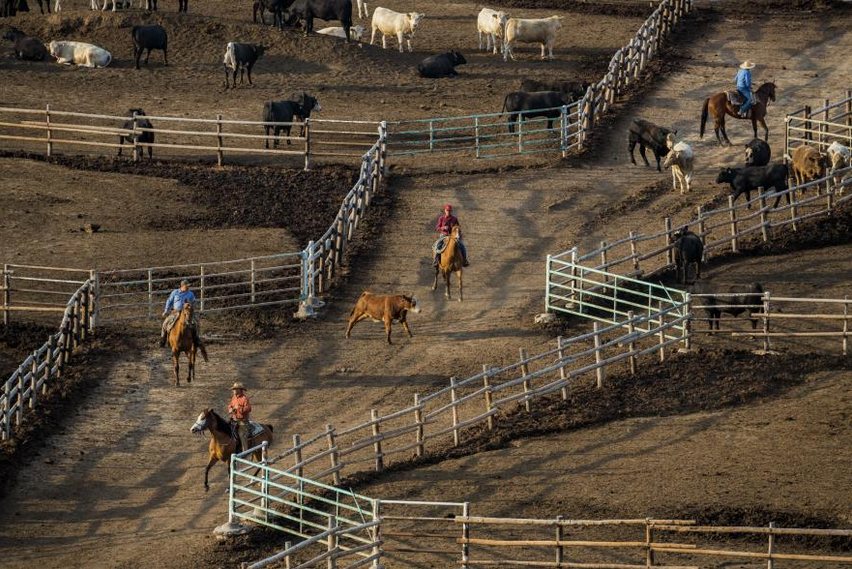
A steer is coaxed into its pen at a feedlot near Garden City, Kansas. Sparse population, a semiarid climate, and abundant groundwater turned the southern High Plains into the world’s feedlot capital. A single quarter-pound hamburger requires about 460 gallons of water to raise and process the beef.
“It comes down to the luck of where your ancestors settled,” Wilson says. “Or where you bought ground.”
In midmorning we arrive at Mai Farms, a family enterprise that grows winter wheat for King Arthur Flour. The Mai family, Germans who emigrated from Russia, arrived in Greeley County just in time for the Dust Bowl but lacked the money to join the exodus to California. Their first farm dusted over and went bust. Their second farm, 20 miles away, survived and thrived. Bill Mai was born on it in 1936 and lives there today. That first well we measured was drilled in 1948 by Mai’s father to carry his farm through cycles of drought. It was a marvel at the time, pumping a thousand gallons a minute, a rate that would fill an Olympic-size swimming pool in half a day. Most telling, however, is not the well’s water level: It’s that Mai hasn’t irrigated crops in 16 years. His neighbors are pulling out so much from their wells that his well drops a foot every year. “The neighbor right across the road here is growing corn,” he says. Irrigated corn makes a lot of money but uses a lot of water. I ask Mai what he can do about this. Nothing, he tells me. A legal battle over water rights “is pointless,” he says, especially since his water will run out anyway.
Mai spent 20 years making the shift back to dryland—or unirrigated—farming, in anticipation that his water would not last. He hands me a yellowed newspaper clipping from 1976, which profiled him as Kansas District 10 farmer of the year. “We don’t have enough water out here anymore,” he warned then. Mai wasn’t the first to say it. Reports on the aquifer as a diminishing resource date back to the 1930s, when President Franklin Roosevelt appointed a Great Plains committee to examine the cause of the Dust Bowl. Even then, the committee noted the contradiction in basing an expanding farm economy on a finite resource.
For the eight states that overlie the Ogallala, differences in the complex hydrology belowground—and in state law, politics, and farming tradition aboveground—conspire against sustaining the aquifer rather than mining it. The states monitor water usage, creating an important record for how much is pumped yearly. But cutting use is more difficult. Groundwater in Kansas and Nebraska, for example, belongs to the public. Water rights are granted to property owners by those states, which assign a certain amount that can be legally used. The problem is that in overstressed areas, what’s available on paper often exceeds what’s left in the ground.
Water law in Texas is vastly different. Groundwater is not publicly owned; Texans can pump as much as they can use from beneath their land. In the High Plains water district surrounding Lubbock, 88,000 irrigation wells were stuck into the aquifer like straws, with 73,000 still in use.
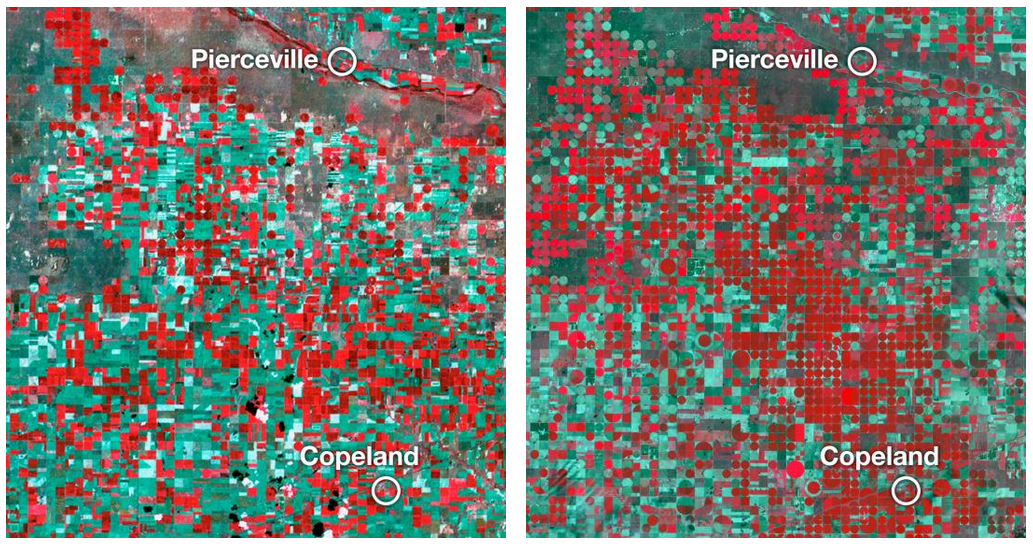
Satellite images from 1972 and 2015 show the dramatic transformation of farmland as rectangular fields gave way to crop circles in southwest Kansas. In this view vegetation appears bright red while sparse grasslands and fallow fields are in shades of green.
Michael Taylor, NASA Goddard Space Flight
Irrigated land is worth more and earns more than dryland farming, and pressure is on to keep pumping—from seed salespeople, farm equipment dealers, bankers, insurers, and landlords. “We’ve overdone a good thing,” says Jay Garetson, a proud fifth-generation farmer in Sublette, Kansas. His eldest son is studying aerospace engineering at the University of Kansas, as missions to Mars seem to hold more allure than becoming the sixth generation to farm the family land. “We know we are overdrafting the Ogallala. But we are all so landlocked into these microeconomic decisions that we can’t manage on a larger level.”
As I head south, I encounter a sense of inevitability and resignation. The phrase “managed depletion” becomes part of the Plains vocabulary in water district boardrooms and Elks lodges. Everywhere I stop, I ask people what will happen and what’s to be done about it. Many are concerned that the water will dry up before the next generation, but they don’t have a solution that won’t cause financial pain—or worse, ruin. Others say they’ll let the wells decide. Some farmers “think it’s their water,” one water manager tells me, “and they ought to be able to mine it like coal until it’s gone.” Beef feedlots, high-value enterprises, will endure, but corn will migrate to states that get more rain. Hope lies in technology; farmers show me iPhone apps that track water use so precisely that as little as a tenth of an inch can be applied to their crops. In Colby, Kansas, Lon Frahm, who farms 30,000 acres of wheat and corn, irrigates with two billion gallons of water yearly. He counts among his farmhands an IT technician who collects data to keep his yields ahead of his declining wells.
As a hedge against declining income when wells go dry, farmers are increasingly tapping into the High Plains’ only truly inexhaustible resource: wind. Across the Plains, I pass wide belts of newly planted wind turbines. Outside Friona, Texas, northwest of Lubbock, Wesley Barnett leases wind rights to an energy company. The going rate runs about $10,000 a year per turbine. “We can’t water our land anymore anyway. For some people, wind is a lifeline,” he says.
Parts of the Ogallala could endure for a century or more. But the aquifer’s heart is at greatest risk of depletion. This overstressed zone runs the width of the Texas Panhandle north 450 miles, from Lubbock to the Kansas-Nebraska state line. There, transition to a new era of permanent depletion is under way.
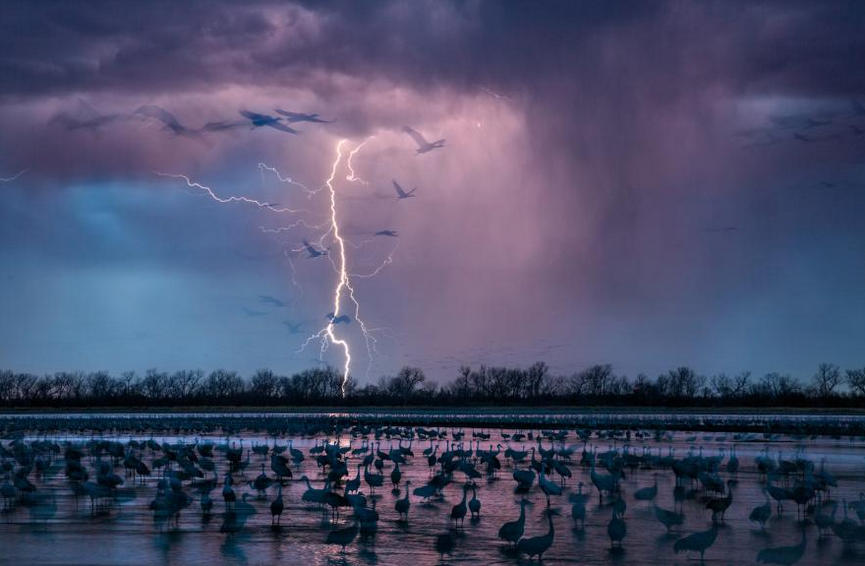
As an evening storm lights up the sky near Wood River, Nebraska, about 413,000 sandhill cranes—tall, bugling, crimson-capped birds—arrive to roost in the shallows of the Platte River, which is fed by the aquifer.
The aquifer’s decline will be twinned with the increasing impacts of climate change, which will add more warm days and longer, more frequent droughts, scientists predict. Already, warmer-than-average evening temperatures in feedlots in southwest Kansas mean that beef cattle drink more water than they did in cooler years. As more farmers return to dryland farming, large farms are likely to swallow smaller family farms, because dry farming, with lower yields, requires more land to be profitable. Irrigation will disappear from most places, so more small towns will fade away. Countless towns across the Plains already teeter on the brink of extinction. The day I visited Lazbuddie, a hiccup of a community in Texas cotton country with fewer than a hundred residents, the postmistress sold a single stamp. This was a week before Christmas.
The irrigation era may come to be called the “great pump up,” bookending the other man-made High Plains disaster—the “great plow up,” when 5.2 million acres of native grasses were torn out, setting the stage for the Dust Bowl. “A couple of generations from now,” says Burke Griggs, a water law expert who teaches at Washburn University in Topeka, “people are going to look back and say: What the hell were they thinking?”
For an expanding nation in the 1800s, the High Plains didn’t hold much promise. The weather—blizzards, tornadoes, and heat waves—could kill. When it rained, it often rained all at once, triggering flash floods. By 1820 the territories that became Nebraska, Kansas, and Oklahoma had been condemned on maps as the Great American Desert, but the cruelest assessment came from the diarist of a U.S. Army survey expedition: “We do not hesitate in giving the opinion, that it is almost wholly unfit for cultivation, and of course uninhabitable by a people depending on agriculture for their subsistence.” Homesteaders moved west anyway, lured by cheap land and railroad promotional schemes that played down climatic shortcomings. New arrivals in Plainview, Texas, stepped out of the train depot and gazed upon sailboats on Lake Plainview. The lake lasted five years, until the pump broke on the well that kept it full. The great plow up followed, as sodbusters converted grassland into wheat fields and put their faith in the mistaken theory that rain follows the plow.
One of the misconceptions about the Dust Bowl is that it could have been prevented if farmers had known what lay beneath their feet. They did. Most farms had shallow wells with windmill-driven pumps. What Plains residents lacked was the ability to drill deep and the horsepower to bring water to the surface in the volumes needed to irrigate more than a family farm. It took rural electrification and the diesel-powered centrifugal pump to launch large-scale pumping in the 1950s. After that, the invention of the center-pivot sprinkler remade agriculture. Irrigated acres on the Plains increased from 2.1 million in 1949 to 15.5 million in 2005. The change recolored dry earth into thousands of lush, green crop circles that can be seen from space.
Ogallala water made Kansas a leading producer of wheat. Ethanol production and the consolidation of beef feedlots in southwest Kansas and the Texas Panhandle made corn king. The world’s largest contiguous cotton-producing land surrounds Lubbock, thanks to Ogallala water. Large scale hog-processing plants and dairies moved into Kansas, Oklahoma, and Texas. Cheese factories followed the dairies. One of North America’s largest cheese plants is outside Clovis, New Mexico, on the aquifer’s western edge. When I visited, it was undergoing a $140 million expansion to become the world’s largest.
“People can fairly argue there is too much development,” says Nate Jenkins, the assistant manager of the Upper Republican Natural Resources District in Imperial, Nebraska. “It was all legally developed, and it’s tough to undo. You can’t move the clock back.”
Cattle feed and ethanol, made from corn, often are singled out as so water consumptive that they put the Ogallala at risk. But William Ashworth, author of Ogallala Blue, a history of the aquifer, argues that what pushed the Ogallala beyond its limits can’t be blamed on dairies or cotton or corn: “It is dairies and cotton and corn. And alfalfa and millet and beef cattle and lawn sprinklers and every other use that demands a piece of the large but limited Ogallala supply. Individually, there ought to be enough water for any of them. Collectively, they are going to run out, and each of them is going to demand that all of the others have to run out first.”
All the Earth’s continents contain aquifers, several larger than the Ogallala. By the beginning of the 21st century, a third of the world depended on aquifers for drinking water and farming. In China, plagued by drought, the North China Plain aquifer sustains 117 million people in Beijing and surrounding areas. Similar aquifers in the Ganges Brahmaputra Basin and the Indus Basin have helped lead to a population boom that will cause India to pass China as the world’s most populous nation by 2022.
The story is virtually the same everywhere. These and other aquifers in several of the world’s most productive, heavily populated regions are being drawn down at precipitous rates. NASA satellites, monitoring changes in Earth’s gravitational pull, found that 21 of the world’s 37 largest aquifers have passed the sustainable tipping point. California’s prolonged drought has driven water levels in much of the Central Valley aquifer to historic lows. India now consumes more groundwater than any other country, and at a faster rate.
Perhaps Saudi Arabia provides the most spectacular example of overdrawing a resource. The Saudis went after the huge Arabian aquifer with a greater passion than they sought their oil, drilling 2,000 feet deep. The dunes turned green with grain, transforming the desert nation into a leading exporter in the 1980s and 1990s. Now the aquifer has been all but emptied. This year wheat wasn’t even planted; the Saudis are growing alfalfa in Arizona and California.
Among the Ogallala states, Nebraska is an exception. Two-thirds of the aquifer’s water lies beneath the Cornhusker State, which ranks first nationally in acres of irrigated cropland. Ogallala water is everywhere. Wetlands and little lakes that appear as brilliant blue jewels are embedded across native bluestem. Rivers boil up out of cattle pastures, gaining in width and strength as they flow east. I spent a day with Doug Hallum, a University of Nebraska hydrologist, wandering the Sand Hills to locate the headwaters of the Dismal River, which oozes to the surface in a sodden pasture not far from CNN founder Ted Turner’s sprawling Blue Creek bison ranch. The region is really a great dune sea, the largest in North America. Rainfall and snowmelt easily percolate through the sand, giving Nebraska the most substantial recharge on the aquifer’s 174,000-square-mile span.
From 2000 to 2008, the years of both a drought and a corn boom, the Ogallala declined at twice the rate of the previous decade, according to Leonard Konikow, a U.S. Geological Survey hydrologist. The aquifer lost, on average, 8.3 million acre-feet per year—equivalent to about half the annual flow of the Colorado River as it runs through the Grand Canyon. The findings did little to inspire cutbacks in water use. “Everyone wants to conserve, but no one wants to quit pumping,” says Ray Luhman, manager of the northernmost groundwater management district in Kansas.
None of the three water districts in western Kansas that overlie the aquifer has agreed on a plan to cut pumping, although farmers surrounding the tiny town of Hoxie took the long view and agreed to a 20 percent reduction in a five-year trial. It is a small oasis of self-regulation in western Kansas—70 farmers over 99 square miles. Just accomplishing that took years of arm-twisting. “We knew something needed to be done,” says Jeff Torluemke, a local banker and farmer. “We’re looking at our kids and grandkids—not just water for irrigation, but water to live. If we continue to pump like there’s no tomorrow, even that would be in jeopardy.”
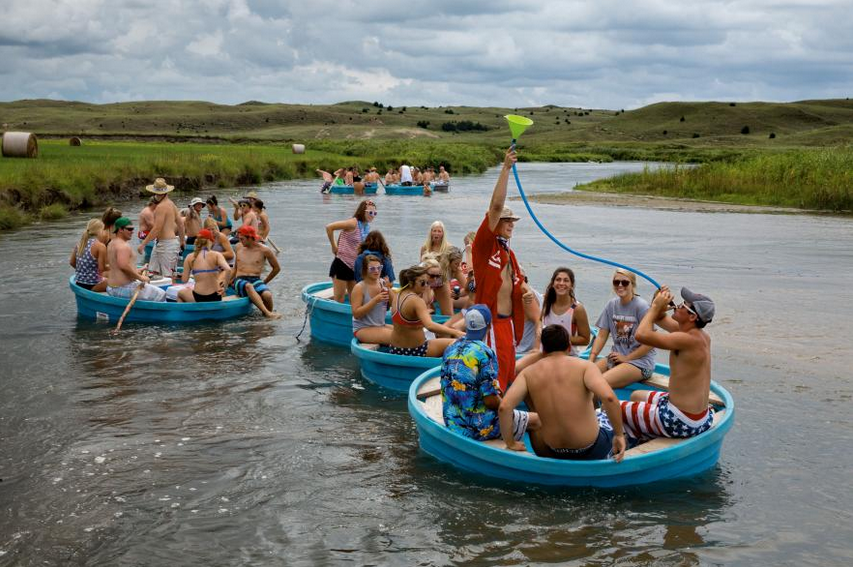
River “tanking” in plastic livestock-watering containers is a popular tourist draw along the shallow Calamus River in central Nebraska. With two-thirds of the Ogallala’s water underlying it, the state’s wealth of groundwater feeds countless springs, streams, and rivers.
In southwest Kansas, one of the most severely depleted areas, hopes are invested in an unlikely-to-be-funded $18 billion aqueduct, a massive public works project of eras long past, that would carry Missouri River water 360 miles uphill. Few expect it to be built, and some call it a distraction from writing a plan, like Hoxie, to scale back water use. Missouri Governor Jay Nixon laughed off the aqueduct as “harebrained.”
This past fall I attended a forum, optimistically titled Farming for the Long Haul, where Julene Bair, author of The Ogallala Road, a memoir about love, loss, and selling the farm that had been in her family for three generations, recounted how her father had heard, as she put it, the Ogallala’s “siren call” and switched from sustainable dryland wheat to unsustainable corn. She spoke emphatically about the failure of volunteer efforts to limit pumping of the aquifer. “Local control is not working,” she told the farmers in the audience. “It asks too much of the farmer to regulate himself. It’s not the farmer’s job to decide about the aquifer, it’s the government’s job.”
The Llano Estacado, the largest flat plateau in North America, spreads out from Odessa north to Amarillo, Texas, and west into New Mexico. The aquifer here is so dry that center-pivot sprinklers draw from multiple wells, the unofficial record being one pivot near Lubbock that draws from 21 wells. Not only is irrigated farming in trouble, but water supplies for surrounding towns are too.
“If people who live on the Ogallala want to see the future,” Jeri Sullivan Graham, a senior scientist at the Los Alamos National Laboratory, tells me, “they should look south and west.”
In Lazbuddie, School Superintendent Joanna Martinez, who also drives the school bus, had waterless urinals installed in the boys’ restrooms. When the community well gave out, it coughed up so much sand it destroyed the school’s plumbing fixtures. Even with a new well, water is so scarce that the football field last year was watered only to soften it up enough to prevent injuries—and then, not on the sidelines or in the end zones.
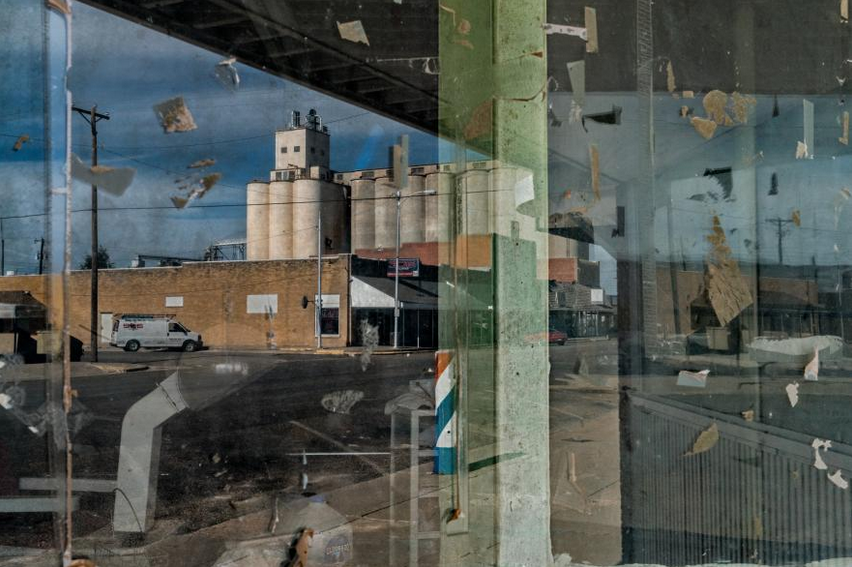
Business is slow midday in downtown Muleshoe, Texas, a 103-year-old community northwest of Lubbock. Small towns struggle in the region, where the Ogallala aquifer is pumped for irrigation.
I cross over the state line into Clovis, a city with ambition but not enough water. Irrigation has drawn the aquifer down so low here that 73 wells deliver less water than what 28 wells delivered to Clovis residents in 2000. “We are in a race to the bottom,” Mayor David Lansford says.
Salvation lies 70 miles north. The eastern New Mexico water authority plans to build a 150-mile pipeline from the Ute Reservoir on the Canadian River to carry water south to Clovis and neighboring towns along the Texas border. Residents in the village of Logan, on the reservoir’s shoreline, fear that this new straw will draw the water down so far it will kill their tourism economy. “Just because you emptied your piggy bank doesn’t mean you get to go break your little brother’s piggy bank and take his money,” says T. J. Smith, a former chamber of commerce head. The pipeline remains unfunded, and in any event, it wouldn’t solve the problems of people such as Buffy Berdoza, who lives beyond the reach of Clovis city water.
Berdoza owns a home just two miles south of town, on Curry Road 5, where all the wells have gone dry. Berdoza is 46 and a home health care aide. Every night after work, she fills more than a dozen five-gallon buckets, sometimes more, in Clovis and hauls them home so her children can flush the toilet and bathe. She has been doing this for four years.
The heart surgeon down the road packed up and moved to Montana, but Berdoza has a mortgage and no chance to sell. Who buys a house without running water? At night, Berdoza says, she dreams about water. The dream is always the same. She is taking a shower or lying in a bath of warm water. She always has plenty.
Groundwater reserves are being depleted all over the world. Read Laura Parker’s extended coverage of aquifers that are disappearing in Asia, Africa, and the Middle East.
